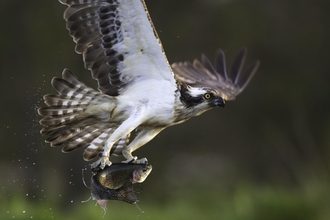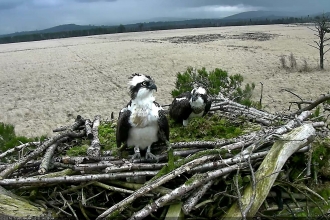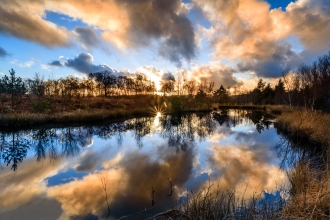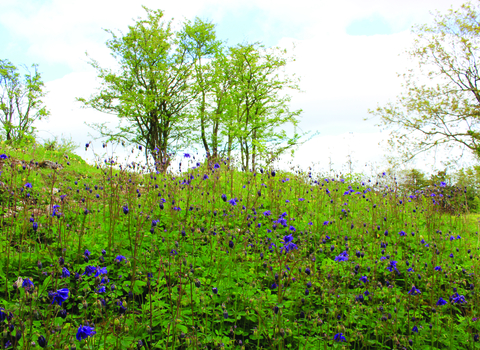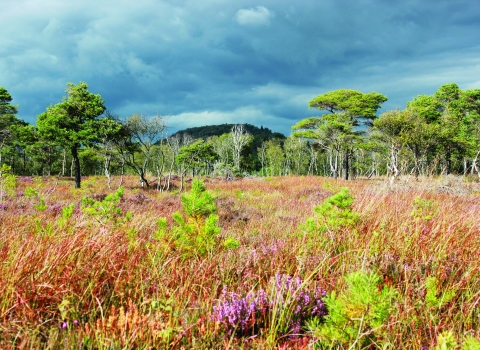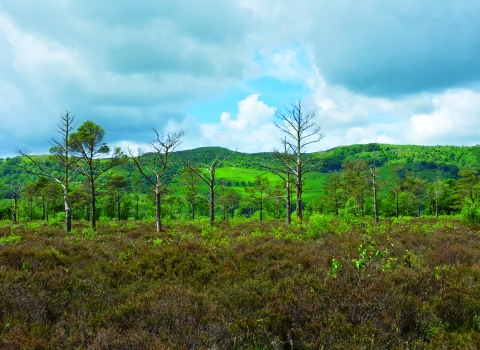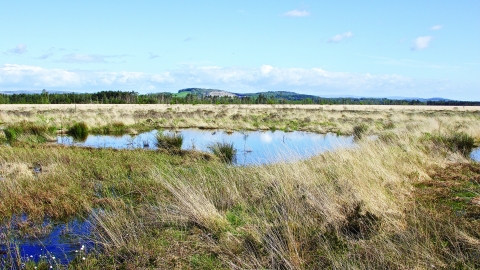
Foulshaw Moss Nature Reserve © Ian Alexander Waite
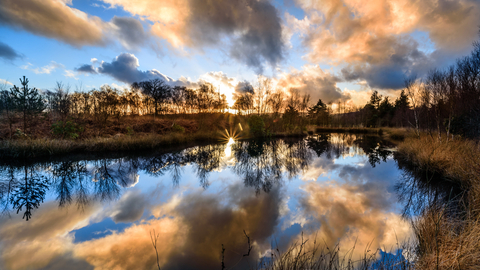
© Les Fitton
White-faced darter dragonfly © David Clarke
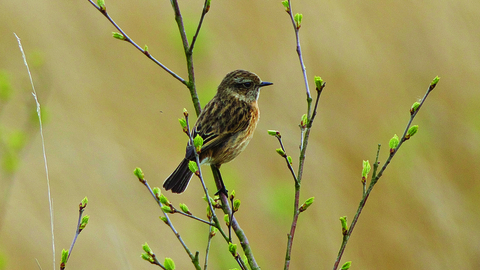
Stone chat © Ian Alexander Waite

Bog-loving cottongrass at Foulshaw Moss Nature Reserve © Bex Lynam

Osprey in flight at Foulshaw Moss Nature Reserve © Emyr Evans

Viviparous or Common lizard (Zootoca vivipara) basking in the early spring, Cannock Chase, Staffordshire. © Danny Green/2020VISION
Foulshaw Moss
Location
OS Map Reference
1:50,000. Sheet 97Reserve car park:
Grid reference: SD 458 837
Getting here:
By car:
From Kendal take A590 towards Barrow-in-Furness. At the end of the dual carriageway at Gilpin Bridge, continue for 1km/0.6 miles. Immediately before a signed parking layby on the west-bound carriageway, a track leaves the road. Go through the gate and follow the track until a small car park is reached.
From Grange/Barrow-in-Furness on the A590, pass the junction for Witherslack and continue for 0.6km/0.4 miles. The track to the reserve is on the right immediately after the parking layby. Please take care when turning into the reserve from this direction, as the road can be extremely busy.
By bicycle:
The reserve is on National Route 70 Walney to Wear (W2W) and National Route 700 The Bay Cycleway.
By public transport:
Buses run from Barrow-in-Furness, Ulverston, Newby Bridge, Grange-over-
Bus service numbers:
Westbound: X6 Kendal - Ulverston, X6 Kendal & Ulverston - Barrow.
Eastbound: X6 Ulverston - Kendal, X6 Barrow - Kendal & Ulverston.
Nearest stops:
Westbound: Low Fell End bus stop, located at the nearby layby, a few minutes walk from the reserve's entrance.
Eastbound: Parkside cottages bus stop, located at the layby on the opposite side of the A590 dual carriageway to the reserve's entrance, a few minutes walk.
This is a guide, for the most up to date timetables please visit: https://www.stagecoachbus.com/timetables
View on What3Words
Know before you go
Dogs
When to visit
Opening times
Open all year roundBest time to visit
April to SeptemberAbout the reserve
A precious peat bog
Peat has formed over thousands of years from the remains of the humble bog plant Sphagnum moss.
These remains, halted from decaying fully due to waterlogging and acidity, have eventually built to form a dome of peat that’s higher than the surrounding land.
Drainage and tree planting in the 1950s–60s meant much of the wetland wildlife was lost, but these species are now returning following the Trust’s ambitious 15-year restoration of the site.
What makes Foulshaw Moss so special?
Lowland raised mires like Foulshaw Moss are one of Western Europe’s rarest and most threatened habitats.
Around 94% of this unique habitat has been destroyed or damaged in the UK, so these remaining areas are incredibly important for a range of wildlife.
Water-loving Sphagnum mosses, carnivorous sundews, cranberry and bog-rosemary are just some of the plants that thrive here, creating a living carpet of colour that’s interspersed with the soft white heads of cottongrass in early summer.
These mossy hummocks and pools provide essential nesting and feeding ground for wetland birds such as moorhen, snipe and the elusive water rail, whilst birds of prey including hobby, sparrowhawk, buzzard and peregrine take advantage of the abundance of prey.
Foulshaw Moss is an incredibly peaceful nature reserve that offers something special for all wildlife enthusiasts.
Although the landscape is challenging, boardwalk makes visiting easy-going, with routes leading through peaty pools or out onto the open moss where many different butterflies, moths and insects are found.
Wildlife highlights
- A pair of ospreys breed here in the summer – enjoy the sight of these majestic birds of prey from the viewing platform as they soar above the moss
- An abundance of dragonflies and damselflies, including the rare white-faced darter and emperor dragonfly, can be seen around the many pools
- Listen for the secretive water rail or head onto the boardwalk to spot tree pipit, stonechat, snipe and teal
- Look for the nationally scarce argent & sable moth which flies during the day
- Spring – Green hairstreak butterflies fly in May, tree pipits and stonechats display over the bog, warblers and cuckoos sing in the woodland, ospreys return from Africa.
- Summer- Huge numbers of dragonflies including the rare white-faced darter dragonfly, large heath butterflies, lizards, adders & nesting ospreys.
- Autumn- Heather flowering purple, migrating birds include ospreys passing through in September, red deer rutting.
- Winter – Both marsh harrier and hen harrier visit the site, large numbers of snipe and teal arrive, and red deer can be seen from the raised platform.
Habitat restoration
In partnership with Natural England, the Trust has been carrying out significant habitat restoration works which aim to raise water levels and secure the long term future of Foulshaw Moss.
Conifer trees have been removed from around the edges as they have served to dry the peat and excavators have blocked drains and created small low bunds that retain water on the bog.
Following the completion of restoration works, improvements to parking and access will be made, with new walkways and signage planned.
Slowly we are seeing the characteristic bog vegetation of Sphagnum moss, cotton grass, cranberry and bog rosemary reclaiming the site.
White-faced darter reintroduction
The white-faced darter is a specialist dragonfly only found in acidic pools on lowland peat bogs.
During the late twentieth century huge swathes of habitat were lost and the white-faced darter was reduced to just two known sites in Cumbria.
In 2010 a joint project with the British Dragonfly Society enabled larvae to be taken from the remaining site and reintroduced to pools at Foulshaw Moss, where they had lived prior to drainage of the bog for forestry in the 1950s.
A total of 55 adult dragonflies were recorded emerging from the introduction pools in 2011. By 2016 numbers were close to 2,000, which is a fantastic success for this rare dragonfly.
Recent history
Foulshaw Moss was purchased in 1998 with help from the Heritage Lottery Fund. Since then, a number of additional areas have been acquired.
Species
- Osprey
- Common lizard
- Red deer
- Adder
- Stonechat
- Emperor dragonfly
- Cuckoo
- Buzzard
- Green hairstreak
- Alder buckthorn
- Chiffchaff
- Common toad
- Common Hawker
- Creeping jenny
- Cross-leaved heath
- Blue-tailed damselfly
- Broad-bodied chaser
- Emerald damselfly
- Great spotted woodpecker
- Sphagnum moss
- Black darter
- Common darter
- Moorhen
- Round-leaved sundew
- Snipe
- Water rail
- Hobby
- Sparrowhawk
- Peregrine falcon
- Tree pipit
- Teal
- Argent & sable
- Large heath
- Marsh harrier
- Hen harrier
- Common cotton-grass
Habitat
Contact us
Not especially large but very interesting to visit. On the weekend we went there were volunteers helping you catch a sight of the ospreys, which had recently hatched out a couple of chicks. There were other animals about too e.g. stonechat, dragonflies and common lizards which my daughter found especially exciting. The path is boardwalk all round and there is a raised viewing platform as well as 2 other hides, one of which had feeders set up to view the birds.
Take a virtual tour of Foulshaw Moss Nature Reserve
Did you know?
White-faced darter dragonflies have declined significantly and are found at only a handful of sites in Cumbria. Our partnership with the British Dragonfly Society helped successfully reintroduce them here in 2010.

Support our conservation work on this nature reserve,
and protect Cumbria's wildlife & wild places.
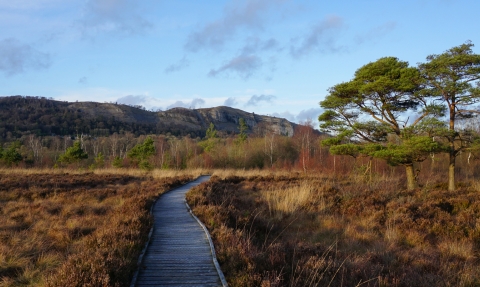
Tony Shaw
Make a difference for Foulshaw Moss Nature Reserve
Upcoming events at Foulshaw Moss Nature Reserve
If there are any upcoming events at Foulshaw Moss Nature Reserve we'll show them to you below.
Further information about Foulshaw Moss Nature Reserve
Thanks to individuals and funders who made a donation to make this project possible.





